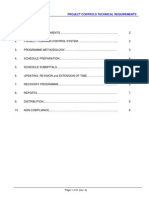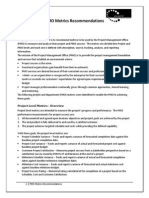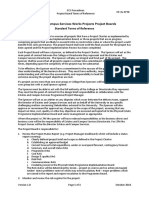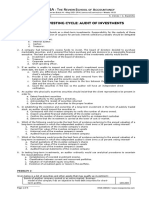Objective: Romp Contractprojectcontrolsrequirements
Objective: Romp Contractprojectcontrolsrequirements
Uploaded by
maxwell777Copyright:
Available Formats
Objective: Romp Contractprojectcontrolsrequirements
Objective: Romp Contractprojectcontrolsrequirements
Uploaded by
maxwell777Original Description:
Original Title
Copyright
Available Formats
Share this document
Did you find this document useful?
Is this content inappropriate?
Copyright:
Available Formats
Objective: Romp Contractprojectcontrolsrequirements
Objective: Romp Contractprojectcontrolsrequirements
Uploaded by
maxwell777Copyright:
Available Formats
Pima County Regional Wastewater Reclamation Department Program Management
ROMP Co ntract Project Contro ls Requ ir ements
1. Objective This guideline is designed to augment current Pima County contract language for Project Controls to assist Project Managers and others in preparing contract requirements specific to Project Schedules, Project Controls and Electronic Documents. 2. Project Schedule 2.1. Software required Primavera Project Manager P6.0 (Oracle) or later 2.2. Composition 2.2.1. Work Breakdown Structure (WBS) The scope of work, schedule and any estimates will be organized by WBS 2.2.2. Scope of Work Activities - Resource loaded (budget/cost) activities that accurately represent the scope of work that are sequenced by using logic (predecessors and successors) that result in a critical path method schedule (CPM). 2.2.3. Organization of Activities All schedule activities are to be organized (by code) via a WBS provided by the Consultant/Contractor subject to approval by the Program Manager/Owner. 2.2.4. Schedule Milestones Schedule milestones are required to reflect key scope of work events that begin, end or represent an interim point within a work process. They are also required to integrate the schedule of values within the project schedule. 2.2.5. Physical Percent Complete (Earned Value) All schedule activity progress will be recorded as the authorized work physically accomplished. Level of Effort (LOE) progress commonly computed as the activitys duration expended to data date divided by total activity duration is applicable to only those activities that are by nature overhead or management that cannot be broken down into smaller discrete activities. These activities are to be identified in the schedule of values or CPM as such. 2.2.6. Cash Flow Curves and Tables As part of the schedule, cash flow curves and tables will be prepared from the resource loaded schedule. The curves will be organized by scope of work total, WBS and any other coded grouping requested by the Program Manager. The curves distribution will be reported by month and by Fiscal Year. 2.3. Baseline Schedule, Current Schedule and Three-Week Look Ahead Schedule 2.3.1. Baseline Schedule The Baseline Schedule represents the scheduled scope of work agreed to between the Owner/Program Manager and Consultant or Contractor. This Baseline schedule is the benchmark upon which schedule, budget (cost) and cash flow progress is compared to determine performance. 2.3.2. Current Schedule The Current Schedule represents the scheduled scope of work progress that is recorded and updated on a periodic basis which is compared to the Baseline Schedule to determine schedule performance. Budget (cost) and cash flow performance. 2.3.3. Three-Week look Ahead Schedule Current week and three weeks ahead. This document must be created from the P6 schedule for consistency. Presenting the schedule in MS Excel with additional detail is acceptable provided the base schedule activities for the period of review are exported from P6. 2.3.4. Presentation of Baseline and Current Schedules The Baseline and Current Schedule activity bars shall be displayed together (per activity) on one schedule to show current performance. The activity data table of the schedule shall show the activities, Baseline
Pima County Wastewater Management Department Tucson, Arizona
Program Management
ROMP Co ntract Project Contro ls Requ ir ements
start and finish dates, Forecast/Actual start and finish dates, duration, physical percent complete and total float. 2.3.5.Submittals 2.3.4.1. WBS and coding plan 2.3.4.2. Preliminary design and/or construction resource loaded schedule in P6 .xer file format (for use in creating an approved Baseline Schedule) 2.3.4.3. Baseline design and/or construction resource loaded schedule in P6 .xer file format 2.3.4.4. Monthly updated Current design and/or construction resource loaded schedule in P6 .xer file format 2.3.4.5. Monthly updated schedule analysis and narrative (see Project Controls) 3. Project Controls 3.1. The consultant/contractor will prepare monthly reports showing the comparison of actual costs and percent complete with baseline cost and percent complete for the scope of work. Project reports will be presented in a format consistent with guidelines provided by the Program manager within 30 days of Notice to Proceed (NTP). 3.2. Periodic Requirements Three-Week Look Ahead Schedule for every Project Coordination or Progress Meeting 3.3. Monthly Requirements 3.2.1. Design/construction schedule status updated 3.2.2. Schedule of Values for progress payment application including physical percent complete 3.2.3. Monthly Status Report Analysis and Narrative 3.2.3.1. Once the baseline design/construction schedule is accepted by the Program Manager the designer/contractor shall be responsible for preparing and submitting update information on logic, physical percent complete, actual start and finish dates, and duration changes. On a date determined by the Program Manager, the designer/contractor shall meet with the Program Manager to review the monthly progress schedule update. The designer/contractor and the Program Manager will review the updated design/construction schedule and discuss the content of the narrative report. All subsequent monthly schedule updates shall be compared to the baseline design/construction schedule. In addition, each current monthly update shall be compared to the last months update. Designer/contractor will send a Primavera .xer file to the Program Manager. The narrative report shall include, but not be limited to, those activities that completed, started, finished or are in progress for the reporting period. 3.2.3.2. Schedule Analysis and Narrative - An analysis of the CPM is required to report the status of the critical path as it relates to delay of the project (if any), changes in total float and changes in the composition of the critical path activities. The analysis results will be written in a narrative format with any supporting graphics as needed.
Pima County Wastewater Management Department Tucson, Arizona
Program Management
ROMP Co ntract Project Contro ls Requ ir ements
4. Project Changes Any change to be made to the Baseline Schedule must be approved by the Owner through a formal change request. The request must address whether the change in the schedule is a result of scope, activity start, finish or duration change, activity sequencing change, budget change or resource loading change among the activities or activity resource curve assignment. 5. Qualifications of Scheduler The consultant/contractor shall employ or retain the services of a full-time onsite Project Scheduler who shall have a minimum of 10 years verifiable experience in design/construction work sequencing and recent experience using the most current version of Primavera Project Manager, Version 6.0 or later. Within thirty (30) days after notice to proceed, the consultant/contractor shall submit the baseline design/construction schedule to the Program Manager including a written narrative to further explain the plan as set forth in the project schedule. The work activities comprising the baseline schedule shall be of sufficient detail to assure adequate planning and execution of the work such that, in the judgment of the Program Manager, it provides an appropriate basis for forecasting, monitoring and evaluating the progress of the work. The baseline design/construction schedule shall begin with the date of issuance of the notice to proceed and not exceed the maximum contract days provided by the contract. 6. Electronic Documentation 6.2. ROMP Document Control System - The ROMP projects are employing an electronic document control system, designated the Pima County Management Information System (PCMIS), based on Primaveras Contract Manager. Except where noted, PCMIS eliminates the need to submit multiple hard copies, sepias, CDs, etc. for required contract submittals. Instead, most documents can be submitted electronically with physical copies required only when copying is impractical or not possible, such as with samples, catalogue cuts, or large drawings. Original documents may also be necessary when original signatures are required; otherwise, electronic transmittals and documentation will be used. ROMP projects will have scanning capability for signed letters and transmittals that are sent; however, in most cases electronic copies of these documents will be sufficient. The detailed requirements can be worked out with the Pima County Project Manager following contract award. Contractors and Consultants needing to use PCMIS will be provided licenses by the County. 6.2.1. Modules of PCMIS that have been deployed and a description of the use of these modules by the County and Contractor/Consultant. 6.2.1.1. Correspondence Received and Sent - The County maintains a complete log and copy of all project correspondence received and sent. All documents generated in PCMIS are copied to the Correspondence Sent module. Electronic, or original scanned documents received by the County are copied into Correspondence Received. 6.2.1.2. Meeting Minutes and Action Items - Agendas for all formal meetings sponsored by the project are generated in PCMIS, and PCMIS is used to record the minutes and action items. Action items are given discrete numbers and are tracked for follow-up actions. Standard meeting templates are used for regular meetings. Consultants and Contractors do not use this
Pima County Wastewater Management Department Tucson, Arizona
Program Management
ROMP Co ntract Project Contro ls Requ ir ements
module. Their meeting minutes are sent electronically to the project administrator. 6.2.1.3. Drawings and Drawing Sets - PCMIS has a module for the storage of all contract drawings and revisions. The County also has a second electronic document control system, designated DMS that is available to authorized project stakeholders. PCMIS is available only to users with a Contract Manager license. Since drawings need to be available to a broader audience, DMS can be used for the storage of drawings in lieu of, or in addition to, PCMIS at the discretion of the Project Manager. 6.2.1.4. Daily Inspection Reports - Daily inspections reports prepared by County inspectors, or by consultants hired to work on behalf of the County, are generated in PCMIS using standard templates. The features in PCMIS make preparation of these reports easier and more consistent than use of word processing software. Daily Reports by contractors are submitted electronically using their software and are stored in PCMIS in Correspondence Received. 6.2.1.5. RFIs (Requests for Information) - RFIs are to be submitted electronically using PCMIS. Answers to RFI questions will be delivered back to the contractor electronically through PCMIS. 6.2.1.6. Submittals - Contractors will provide a submittal register at the beginning of the contract (per the Submittals specification) and the County or its consultant will record the entries in PCMIS. Individual submittals will be submitted electronically through PCMIS by the Contractor, with the provision that non-scanable items be delivered manually the same day and noted in the submittal. Submittal responses will be provided back to the Contractor electronically. 6.2.1.7. Payment Applications - Payment applications can be submitted either electronically by the Contractor using PCMIS or manually, and the PM staff will enter the information into the Payment Application module. This decision is at the discretion of the project manager. 6.2.1.8. Change Management - Changes to Contracts or Purchase Orders are managed using the Change Management module. Change Notice (County initiated) or Change Request (Contractor initiated) documents are prepared outside of PCMIS. Amounts and negotiations are tracked using PCMIS. Final changes to be submitted for County department or board approval are prepared in the PCMIS. 6.3. ROMP Document Management System (DMS) The ROMP Document Management System is based on Microsoft SharePoint. This system is used for storage and retrieval of documents not prepared and stored in the PCMIS (Contract Manager) and for PCMIS documents that is shared to program and project stakeholders who do not have access to the PCMIS. The decision regarding which documents are to be stored in both systems is determined by the Pima County Project Manager. The system is web-based and operated by the ROMP. 6.3.1. Consultant/Contractor Requirements All consultants and contractors may be given access to a Document Library within the DMS for the purpose of uploading contract deliverables and downloading documents from Pima County.
Pima County Wastewater Management Department Tucson, Arizona
Program Management
ROMP Co ntract Project Contro ls Requ ir ements
6.3.2.
6.3.3.
Access and Training The ROMP program will provide access to this system on an asneeded basis and provide any training required for Consultant/Contract users. Since the system is intuitive, instructions for use are given at the time access is enabled. Physical Documents (hard copy) Use of the ROMP DMS does not relieve the consultant or contractor of the requirement to provide hard copy or wet signature documents as required by the Pima County Project Manager, ROMP Program Manager or Pima County contract with the consultant or contractor.
You might also like
- Project Controls ProcedureDocument14 pagesProject Controls Proceduresaleem_b91% (11)
- Project Cost Control ProcedureDocument3 pagesProject Cost Control Procedurebuddylucena100% (12)
- 1.6 Project Control PlanDocument11 pages1.6 Project Control Planaswar100% (1)
- I Am Decrees PDFDocument5 pagesI Am Decrees PDFmaxwell777100% (9)
- The Role of Information Systems in An OrganizationDocument27 pagesThe Role of Information Systems in An OrganizationChow Dhury100% (4)
- Integrated Cost and Schedule Control in Project ManagementFrom EverandIntegrated Cost and Schedule Control in Project ManagementRating: 2 out of 5 stars2/5 (1)
- Project Management Fundamentals: Key Concepts and MethodologyFrom EverandProject Management Fundamentals: Key Concepts and MethodologyRating: 5 out of 5 stars5/5 (5)
- A Project Report On ItcDocument55 pagesA Project Report On ItcAbhishek Mittal73% (11)
- Project Implementation PlanDocument13 pagesProject Implementation PlanHassan Ahmadu100% (1)
- Planing Procedure Rev01Document12 pagesPlaning Procedure Rev01Olakanmiismail Alabi88% (8)
- Program Level SchedulingDocument7 pagesProgram Level SchedulingHatem HejaziNo ratings yet
- Abundance Work BookDocument27 pagesAbundance Work Bookmaxwell777100% (2)
- Advanced Accounting: An Introduction To Consolidated Financial StatementsDocument57 pagesAdvanced Accounting: An Introduction To Consolidated Financial StatementsgabiNo ratings yet
- 84501-9200-9L-006 Rev.2 Contractor Planning and Scheduling Requirements (EPCI ContractsDocument33 pages84501-9200-9L-006 Rev.2 Contractor Planning and Scheduling Requirements (EPCI ContractsPeni M. Saptoargo100% (2)
- WNS00 PP PC 0001Document11 pagesWNS00 PP PC 0001Subramanian Saravanan100% (1)
- The Project Manager's Checklist for Building Projects: Delivery Strategies & ProcessesFrom EverandThe Project Manager's Checklist for Building Projects: Delivery Strategies & ProcessesNo ratings yet
- Project Estimating and Cost ManagementFrom EverandProject Estimating and Cost ManagementRating: 4.5 out of 5 stars4.5/5 (12)
- Deep Subconscious HealingDocument7 pagesDeep Subconscious Healingmaxwell777100% (6)
- Detail Unit Price Analysis 1Document4 pagesDetail Unit Price Analysis 1Miks BideoNo ratings yet
- Bergerac Systems: The Challenge of Backward IntegrationDocument8 pagesBergerac Systems: The Challenge of Backward IntegrationSujith KumarNo ratings yet
- GR Pcs Epco Requirements Final Rev 2Document8 pagesGR Pcs Epco Requirements Final Rev 2Juan Dela CruzNo ratings yet
- Project Controls ProcedureDocument12 pagesProject Controls ProcedureNashrul KarimNo ratings yet
- Proposition 1B Project Close-Out ProcessDocument4 pagesProposition 1B Project Close-Out ProcessFarhana Azmira AsmadiNo ratings yet
- Project Controls Specification SummaryDocument16 pagesProject Controls Specification SummaryKhaled AbdelbakiNo ratings yet
- Primavera Cost LoadingDocument5 pagesPrimavera Cost LoadingGerry TriazNo ratings yet
- Schedule MGMT PlanDocument32 pagesSchedule MGMT PlanDrMohamed MustaqNo ratings yet
- Schedule Management Plan Example W22Document2 pagesSchedule Management Plan Example W22voru89No ratings yet
- Construction Schedule RequirementsDocument4 pagesConstruction Schedule Requirementsedla3710No ratings yet
- CRS Project-Management-PlanDocument12 pagesCRS Project-Management-PlanGervie Cabang PalattaoNo ratings yet
- 3-10 Vol-3 Empl Reqt - Appendix-1 To 9Document88 pages3-10 Vol-3 Empl Reqt - Appendix-1 To 9raviteja_235998131No ratings yet
- PM NotesDocument23 pagesPM Noteschandar70No ratings yet
- As Built ScheduleDocument7 pagesAs Built ScheduleDayana Romero MonroyNo ratings yet
- Free Material 440803300Document13 pagesFree Material 440803300Dina TaherNo ratings yet
- Excercise 2 Chapter 7Document7 pagesExcercise 2 Chapter 7tatamaria15No ratings yet
- Volantic PMO Metrics RecommendationsDocument22 pagesVolantic PMO Metrics RecommendationsSergio IvánNo ratings yet
- CPM According To Contract & CPM ChecklistDocument5 pagesCPM According To Contract & CPM Checklistarmon_terra6220No ratings yet
- مواصفات إعداد الجداول الزمنيةDocument18 pagesمواصفات إعداد الجداول الزمنيةFührer Magdi BadranNo ratings yet
- Projects Control FEEDDocument12 pagesProjects Control FEEDRic S. MalongaNo ratings yet
- Projects Control FEEDDocument12 pagesProjects Control FEEDRic S. Malonga100% (1)
- ScheduleDocument12 pagesScheduleRic S. MalongaNo ratings yet
- ChapterDocument60 pagesChapterMa ThiNo ratings yet
- Proposed Work ProgrammeDocument8 pagesProposed Work Programmevarshil_parikhNo ratings yet
- C2022 04Document72 pagesC2022 04Leo2pbNo ratings yet
- Standard Planning ProcedureDocument16 pagesStandard Planning ProcedureNicholas PorterNo ratings yet
- Role Definitions: Sps Project Senior Program Manager (SPM) Duties & ResponsibilitiesDocument11 pagesRole Definitions: Sps Project Senior Program Manager (SPM) Duties & ResponsibilitiesRaul DavisNo ratings yet
- Primavera TrainingDocument160 pagesPrimavera TrainingSyed Rizwan100% (6)
- Project Planning ProcedureDocument9 pagesProject Planning ProcedureCristian Lukacs100% (6)
- 3.6 A. Schedule Control ProcedureDocument6 pages3.6 A. Schedule Control ProcedureChiamaka ObadiegwuNo ratings yet
- CMS Deliverable Review Process PDFDocument43 pagesCMS Deliverable Review Process PDFEko KurniawanNo ratings yet
- PP-16-Project Board Terms of ReferenceDocument3 pagesPP-16-Project Board Terms of ReferenceSALAH HELLARANo ratings yet
- 088 FIDIC 2017 Programme ClausesDocument9 pages088 FIDIC 2017 Programme Clausessellitt ngNo ratings yet
- Section3 PDFDocument18 pagesSection3 PDFKidist AlemayehuNo ratings yet
- Project Control System ManualDocument29 pagesProject Control System ManualekoinNo ratings yet
- Time Scheduling A ProjectDocument63 pagesTime Scheduling A ProjectRavneet S. LoteyNo ratings yet
- Contract Manager FunctionalDocument44 pagesContract Manager FunctionalDiego Ahumada Soto100% (1)
- Vii 2Document77 pagesVii 2seventhNo ratings yet
- Planning and SchedulingDocument65 pagesPlanning and Schedulingrachid19027467% (3)
- Dao 99-38Document4 pagesDao 99-38olivenzashalomaeNo ratings yet
- Cost Control FSCRBDDocument9 pagesCost Control FSCRBDWilson OrbeaNo ratings yet
- Planning SpecificsDocument3 pagesPlanning Specificsgodwinirabor48No ratings yet
- Nysdot P6client Training ManualDocument120 pagesNysdot P6client Training Manualonur ozNo ratings yet
- Five Components of The Project Management Information SystemDocument2 pagesFive Components of The Project Management Information SystemsevNo ratings yet
- (01 32 16) Construction Schedule Critical Path Method-CPMDocument7 pages(01 32 16) Construction Schedule Critical Path Method-CPMAmeer JoshiNo ratings yet
- 01 32 17.00 20 - Contractor - Baseline - Project - Schedule - Review - ChecklistDocument6 pages01 32 17.00 20 - Contractor - Baseline - Project - Schedule - Review - ChecklistErwin ObenzaNo ratings yet
- Quality Control & Construction Management Manual: 110802-Qc&CmmanualDocument4 pagesQuality Control & Construction Management Manual: 110802-Qc&CmmanualshalikamanojNo ratings yet
- Introduction to Project Management: The Quick Reference HandbookFrom EverandIntroduction to Project Management: The Quick Reference HandbookNo ratings yet
- Introduction and Overview of Subsea EngineeringDocument58 pagesIntroduction and Overview of Subsea Engineeringmaxwell777100% (3)
- Wiley Sec D 2021 MCQDocument673 pagesWiley Sec D 2021 MCQAbd-Ullah AtefNo ratings yet
- Going Concern - ACCA Qualification - Students - ACCA GlobalDocument5 pagesGoing Concern - ACCA Qualification - Students - ACCA GlobalStavri Makri SmirilliNo ratings yet
- Ap 600Document5 pagesAp 600Christine Jane AbangNo ratings yet
- PMP 123 Short Version2Document151 pagesPMP 123 Short Version2LindaBalboulNo ratings yet
- Edit 0: Basic CompetenciesDocument6 pagesEdit 0: Basic CompetenciesTrixx CarranzaNo ratings yet
- Chapter Five Institutionalizing StrategyDocument75 pagesChapter Five Institutionalizing Strategybutwalservice100% (4)
- PII Bahan Ajar Administrasi Kontrak 01aDocument27 pagesPII Bahan Ajar Administrasi Kontrak 01aTaufiq AkbarNo ratings yet
- Rona Initiating CoverageDocument72 pagesRona Initiating CoverageIñigo González De CastejónNo ratings yet
- Task 3 - PrivatisationDocument6 pagesTask 3 - PrivatisationMuhamad RahmadNo ratings yet
- OceanofPDF - Com How To Be A Billionaire - Martin S FridsonDocument11 pagesOceanofPDF - Com How To Be A Billionaire - Martin S FridsonBasheer AhmedNo ratings yet
- TAC QuickReferenceGuideDocument4 pagesTAC QuickReferenceGuideGabriel Gonzalez LopezNo ratings yet
- Guess - Eu: Description Qty Custom Code Country of Origin Weight Price Per Unit (EUR) Item Discount (EUR) Total (EUR)Document2 pagesGuess - Eu: Description Qty Custom Code Country of Origin Weight Price Per Unit (EUR) Item Discount (EUR) Total (EUR)anneNo ratings yet
- FM MCQDocument96 pagesFM MCQwoodcutaxe.0vNo ratings yet
- Hosconnn Brochure-1Document12 pagesHosconnn Brochure-1India Heals-2020No ratings yet
- MGMT 3003 Group 1 Case StudyDocument38 pagesMGMT 3003 Group 1 Case Studytwo doubleNo ratings yet
- Sco Jet A1 Company Alpha KMG FadoxDocument2 pagesSco Jet A1 Company Alpha KMG FadoxGubre StoreNo ratings yet
- PLM LECTURES COST ACCOUNTING-GLORIA RANTE - Doc1Document13 pagesPLM LECTURES COST ACCOUNTING-GLORIA RANTE - Doc1Angelita Alonzo57% (7)
- Hanif Project Proposal PresentationDocument10 pagesHanif Project Proposal PresentationAbdur Rahat TarekNo ratings yet
- DM21A24 - Hitakshi ThakkarDocument8 pagesDM21A24 - Hitakshi ThakkarRAHUL DUTTANo ratings yet
- Impact of Worklife BalanceDocument5 pagesImpact of Worklife BalanceDr D DivyaNo ratings yet
- Wa0004.Document3 pagesWa0004.Pawan BodhankarNo ratings yet
- TQM Implementation Issues Review and Case StudyDocument14 pagesTQM Implementation Issues Review and Case StudyTharundevasiaNo ratings yet
- Vann Paper TAXDocument50 pagesVann Paper TAXMitiku ShewaNo ratings yet
- Mergers, Acquisitions & TakeoversDocument5 pagesMergers, Acquisitions & TakeoversvamshiNo ratings yet
- Unit 6 - MCQs AnswersDocument94 pagesUnit 6 - MCQs Answersnaffiyy006No ratings yet





























































































